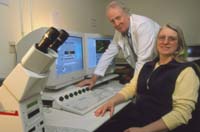| Winter 2004 |
||
| PREVIOUS|PAGE 1 | ||
| Saving
the Chestnut? Carol Budd |

Carol Budd and spouse, Thomas Budd |
|
| The Fall 2003 issue of Labstracts described an effort to use handheld computers (PDAs), GPS, and free, downloadable, field data acquisition software called Cybertracker™. The details of the setup are described in that article. We purchased the equipment to help first semester General Biology students collect field data in support of their independent projects. Our General Biology courses require students to develop, perform and present independent projects both semesters as an exercise in practicing scientific method. At times, I wonder about the value of the exercise, but the following example explains why I have confidence in the process. I should also add that many other projects are worthy of mention, but the one I describe here used map-creation software called ArcView 3.3. Mollie Driscoll’s (’05) project is noteworthy, and I would like to share the outcome and some of the excitement for biology engendered by this student’s use of GIS. St. Lawrence University (SLU) has one of the largest remaining American chestnut (Castanea dentate) trees in New York State. The chestnut range once spanned the entire eastern coast from southern Canada to Georgia and west to the Mississippi River. In the 1900’s, the lethal fungus that causes chestnut blight, Cryphonectria parasitica, was accidentally imported from Asia via the Chinese chestnut and spread throughout the American chestnut population. The blight is spread by spores carried by wind, birds, insects and humans. By the 1950s, virtually no remnant populations of the tree remained in the U.S. Blighted trees rarely reach the five-foot diameter of original trees and are susceptible to wind and storm damage. The January 1998 ice storm in northern New York damaged SLU’s two remaining trees, and consultant arborists made specific recommendations for their maintenance. The smaller, less healthy specimen was cut down due to the ice storm damage. The chestnut does not self-pollinate, and for this reason, trees need to be planted in pairs no farther than 500 feet apart. The removal of the smaller tree ensured that the remaining relic tree would never bear fruit. After attending the American Chestnut Federation Regional Meeting held in the nearby Thousand Islands in October, Mollie returned home with several seedling chestnut trees and multiple nuts. Her attendance for the research reports enlightened her on a potential correlation between the mycorrhizal systems of the chestnut and oak trees. Horton (2003) suggested that chestnut trees planted next to established oaks could incorporate oak mycorrhizae into their root systems, thus enhancing their chance at survival. In addition to the non-fertile burrs collected from the lone SLU tree, Mollie asked two questions: “How do I germinate the chestnuts, and once germinated, where do I plant them?” To answer the germination question, Mollie mimicked the over-wintering conditions of the fruits in northern New York to depress abscisic acid levels to possibly stimulate germination. Her second question required the use of GIS. The SLU library maintains a suite of digital orthoquad (DOQ) maps for the entire region. A map of local environs was easily accessible from this database. Mollie opened ArcView 3.3 on her local desktop, opened the regional DOQ map theme from the library archive, and then overlaid a second soils theme available from the same archive. She was able to locate oak trees on campus by visual inspection. The three data layers then allowed Mollie to pinpoint locations to plant germinated chestnuts on campus. To my surprise, she entertained the idea of developing a summer fellowship proposal to pollinate the mighty tree, collect the subsequent fruit, germinate the seeds, and then plant them. I was certainly excited by the initial project. The subsequent design of additional projects was personally gratifying and certainly demonstrated the power of independent projects at a youthful academic age for engendering enthusiasm for scientific method. I guess we’ll keep at it. Reference:
|
||
| PREVIOUS|PAGE 1 | ||